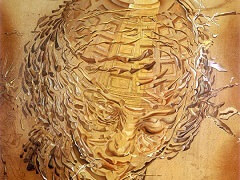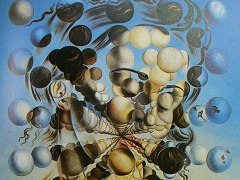Mirage, 1946 by Salvador Dali

While Surrealists such as Rene Magritte generally focused on unlocking the mystery of everyday objects, Salvador Dali populated his visionary landscapes with the often creatures of his imagination. Dali also favored dazzling displays of painterly skill, rather than the deadpan realism of Magritte, in giving his scenes a dramatic and hallucinatory intensity.
In Mirage Dali uses the conventional notion of a mirage as seen in the desert, as a metaphor for a girl's illusion of love. Shown acclaiming a white desert flower that emanates from the head of Apollo, it is uncertain whether the vision stems from the girl's imagination or is a hallucinatory apparition emerging from the radiating heat on the desert horizon.
Dali described the subject of this painting as follows:
The encounter of a beautiful woman (Venus) with Apollo in the desert symbolizes the mirage of love. The aura of classic antiquities and the desert flowers issuing from the forehead of Apollo evokes the timeless feeling of love."
This theme of the 'mirage of love' is one that permeates much Surrealist thinking and also lies at the center of Dali's intense if the bizarre relationship with his wife and muse Gala.























